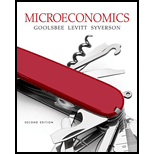
(a)
The partial equilibrium effects of the change in the
(a)
Explanation of Solution
The new quantity demanded of wine can represented as follows:
The supply of wine is given as
Now, set the price of wine as a function of the price of cheese where the price of cheese is constant.
Therefore, the price function of wine is
Now, substitute the value of cheese into the price function of wine.
Therefore, the partial equilibrium effect of the change in the demand for wine causes to decrease the price by $5.
(b)
The demand in the cheese market.
(b)
Explanation of Solution
The quantity demanded of cheese is given by
If the price of wine falls to $5 due to the demand changes, the new demand function of cheese can be represented as follows:
Here, the new demand function of cheese shows that a fall in the price of wine causes the demand for cheese to increase.
(c)
The effects of demand changes.
(c)
Explanation of Solution
The new quantity demanded of cheese market is
Now, set the price of cheese as a function of the price of wine.
Therefore, the price of cheese is $12.5.
Now, substitute the respective value into the supply function.
Therefore, the quantity supply of cheese is12.5 units.
Hence, due to the change in demand for cheese, the price of cheese increases by $2.5
(d)
The price of wine.
(d)
Explanation of Solution
Substitute the respective value of the price of cheese into the price function of wine.
Therefore, the new price of wine is $3.75 which means the demand for wine decreases due to the higher price of cheese.
The quantity supplied of wine can be represented as follows:
Substitute the respective values into the demand function for wine.
Therefore, the quantity of wine produced is 3.75.
Hence, both price and quantity of wine falls by 3.75. Therefore, the wine market pushed farther from its initial equilibrium. Therefore, this decrease in the price of wine market causes to increase the demand for cheese.
(e)
The
(e)
Explanation of Solution
The quantity demanded of cheese is given by
Now, set the price of cheese as a function of the price of wine.
Therefore, the price of cheese is
The quantity demanded of wine market is
Now, set the price of wine as a function of price of cheese.
Therefore, the price of wine is
Substitute the price function of wine in to the price function of cheese to get the value of the price of cheese.
Therefore, the price of cheese is $13.33.
Since the price function of wine is
Therefore, the price of wine is $3.33.
Substitute the respective values into the demand function for wine.
Therefore, the quantity of wine produced is 3.33.
Substitute the respective values into the demand function of cheese.
Therefore, the quantity of cheese produced is 13.33.
Hence, the equilibrium quantities of wine is 3.33 units and cheese is 13.33 units.
(f)
The general equilibrium analysis of price and quantities of wine compared with the partial equilibrium analysis.
(f)
Explanation of Solution
As part (a) describes, the partial equilibrium analysis shows that the changes in demand causes to reduce the price and quantity of wine by more than five from the initial value. In part (e), the general equilibrium analysis describes that the price and quantity of wine decreases by 6.66 (10-3.33). Hence, the general equilibrium analysis shows a higher value of price and quantity of wine than the partial equilibrium analysis.
General equilibrium analysis: The general equilibrium analysis is the study of market behaviour that accounts for cross-market influences and is concerned with conditions present when all markets are simultaneously in equilibrium.
Partial equilibrium analysis: The Partial equilibrium analysis is the determination of the equilibrium in a particular market that assumes there are no cross-market spill overs.
Want to see more full solutions like this?
Chapter 15 Solutions
Microeconomics

 Principles of Economics (12th Edition)EconomicsISBN:9780134078779Author:Karl E. Case, Ray C. Fair, Sharon E. OsterPublisher:PEARSON
Principles of Economics (12th Edition)EconomicsISBN:9780134078779Author:Karl E. Case, Ray C. Fair, Sharon E. OsterPublisher:PEARSON Engineering Economy (17th Edition)EconomicsISBN:9780134870069Author:William G. Sullivan, Elin M. Wicks, C. Patrick KoellingPublisher:PEARSON
Engineering Economy (17th Edition)EconomicsISBN:9780134870069Author:William G. Sullivan, Elin M. Wicks, C. Patrick KoellingPublisher:PEARSON Principles of Economics (MindTap Course List)EconomicsISBN:9781305585126Author:N. Gregory MankiwPublisher:Cengage Learning
Principles of Economics (MindTap Course List)EconomicsISBN:9781305585126Author:N. Gregory MankiwPublisher:Cengage Learning Managerial Economics: A Problem Solving ApproachEconomicsISBN:9781337106665Author:Luke M. Froeb, Brian T. McCann, Michael R. Ward, Mike ShorPublisher:Cengage Learning
Managerial Economics: A Problem Solving ApproachEconomicsISBN:9781337106665Author:Luke M. Froeb, Brian T. McCann, Michael R. Ward, Mike ShorPublisher:Cengage Learning Managerial Economics & Business Strategy (Mcgraw-...EconomicsISBN:9781259290619Author:Michael Baye, Jeff PrincePublisher:McGraw-Hill Education
Managerial Economics & Business Strategy (Mcgraw-...EconomicsISBN:9781259290619Author:Michael Baye, Jeff PrincePublisher:McGraw-Hill Education





